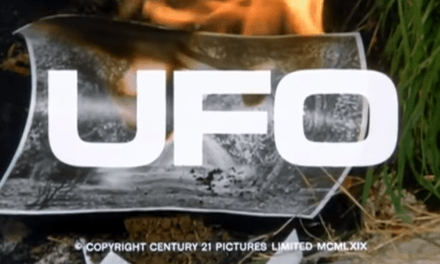
I’m now seven months into perhaps my most ambitious viewing marathon, the complete Doctor Who cycle, watched at the rate of one episode every day. Thanks to the completion of the BBC DVD range last year I started in December and am still only up to spring 1968 (‘Fury From The Deep’ 2 this morning). If I can be bothered to watch the 21st century episodes (far too modern to be an appealing prospect for a historian like myself) this project will take me up to Spring 2016. The process of watching in sequence has demonstrated two particular things to me as a viewer, the benefits of both chronological and episodic viewing.
Understandably, people are more interested in the practical details of such a viewing campaign than the actual programme. It’s an obvious thing to say, but watching a 25-minute programme daily is twice as easy as watching a 50-minute one. I generally watch soon after breakfast, and find that being made to consider old television drama early each day aids my general thinking about it. The cycle has also acted as a handy Gazetteer of the various emotional upheavals, disappointments and modest achievements of my life this year, as I tend to remember what I was watching at the time each thing happened. Occasional alterations to my schedule have added to my emotional engagement in the process – so far the earliest I’ve seen something has been ‘The Ice Warriors’ 4 at 4 a.m. in a Glasgow hotel room during the Screen Conference, while the latest has been ‘The Romans’ 3 at 11.20 p.m. having got back home after a flight from Belfast.
The main practical difficulty has been the 97 missing episodes, but making do has been an instructive archaeological experience. We might not have moving pictures, but we do have off-air recorded soundtracks for every minute of Doctor Who, as well as telesnaps (a commercial photographic enterprise that provided off-air screen grabs to provide directors and designers with a record of their work) for about three-fifths of the missing episodes. For episodes without telesnaps I read the camera script as I listen. Combining these sources to ‘watch’ the missing episodes is an imaginative skill that can be acquired quickly, and there’s normally enough to pick up on – a good script, interesting vocal performances or striking designs in the snaps – to make a satisfying experience, although being reintroduced to moving pictures after a long stretch of missing stories is always disproportionately exciting.
The great benefit of watching in sequence is that advances in television technique, and developments in the form of Doctor Who, come to carry a revelatory force when experienced in context, even in stories that I’ve seen many times before. A good case in point is the series’ first significant use of location filming (in ‘The Dalek Invasion of Earth’ (1964)) when the Doctor and Ian Chesterton explore some eerily deserted Thameside wastelands and crumbling warehouses. In all my previous viewings, I’d mildly enjoyed these scenes as a well-achieved bit of local colour, but when experienced after 45 episodes in which nothing like this has been previously shown, it becomes much more unnerving than it ever was before, as suddenly the visual grammar and sheer terrain of the show expands right in front of the viewer’s eyes. Similarly, it takes until ‘The Ark’ (1966) for the show to first attempt a crane shot, and that story’s attempted sense of spectacle suddenly hit me as never before, inspiring much more of the sense of wonder and exploration that the original audience must have experienced.

As a series consisting of serials, twentieth century Doctor Who had a relatively unusual (though scarcely unique) format and, since the advent of home video in the 1980s, the usual way for most viewers to experience old episodes has been as self-contained stories, usually told in four or six parts. Watching old Doctor Who in this quasi-movie form is an exercise that does the original programme no favours. The narrative flaws endemic to episodic production and storytelling – the repetitive exposition of plotlines required each week, the need to edit or pad each episode to fill 25 minutes, cliff hangers that are exposed as easily resolved problems when the next part immediately follows on – are exposed as glaring.
I always have a niggling feeling that I’m doing something aesthetically wrong when watching a glut of episodic television. Seeing old Doctor Who stories this way, I often had one of two feelings when the credits of an individual part rolled; either “That was great, let’s watch another one” or, “For God’s sake let’s get this bloody thing over before I go to bed tonight”. Each of these responses discourages discriminating appreciation, the first a denial of the pleasure of anticipation, the time spent reflecting on the last episode while looking forward to picking up the story in the next one, while the second turns viewing into a chore, something to tick off a list.
The great thing about daily viewing is that it has made me view Doctor Who (and other programmes that I’ve done this with) more sympathetically and with greater appreciation than otherwise. The notorious serial ‘The Web Planet’ (1965) – in which the Doctor and his companions are the only humanoid characters in a land populated by giant ants and butterflies, a place rendered otherworldly by the camera lenses shooting through gauze – is legendary for its difficulty to watch, with many viewers failing to get beyond an episode or two before abandoning the story. Once stretched over six days, and on the back of a couple of months of accumulated goodwill and detailed understanding of the regular actors’ performances, my fascination at the weird and experimental ambition of the enterprise became greater than my exasperation with the technical ineptitude and lack of conventional dramatic interest for the first time. Paradoxically, the two stories that I’ve enjoyed less as a part of this exercise have been the ones that I thought would have worked particularly well when viewed in instalments. Terry Nation’s stories ‘The Keys of Marinus’ (1964) and ‘The Chase’ (1965) are both picaresque tales that move to a different location each episode (over six parts ‘Marinus’ hops from beach to palace to jungle to ice world to courtroom to temple). When watched in one go, the major advantage of these adventures is the variety of location, but with viewing stretched over six days, I found that each segment’s shoddy execution became more, rather than less apparent.
Re-watching Doctor Who in this fashion has acutely awakened the pleasure that I take in the individual episode, as much as the series. It’s a more modest pleasure but – in being glad of my brief admission into a dramatic world each day – one much closer to the experience of the original 1960s viewer, and a feeling that its instructive to bring to my analysis of television as a whole.
Billy Smart is Research Officer at the AHRC-funded ‘Forgotten British Television drama: 1946-1982’ project at Royal Holloway.





